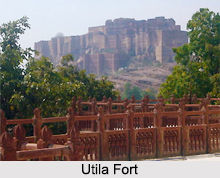 Utila Fort is a small fort in the Utila village located in the Gwalior district of Madhya Pradesh. The village is distanced 20 kilometres east from the city of Gwalior on the Gwalior-Hastinapur-Behat road. The fort, also known as "Ranaon ki Garhi" that literally means the "Fort of the Ranas (rulers)", was constructed around 1740 by Maharaja Bhim Singh Rana. He was the Jat ruler of the erstwhile princely state of Gohad. The geographical coordinates of Utila Fort are 26 degree 9`48.44" N and 78 degree 19`59.11" E.
Utila Fort is a small fort in the Utila village located in the Gwalior district of Madhya Pradesh. The village is distanced 20 kilometres east from the city of Gwalior on the Gwalior-Hastinapur-Behat road. The fort, also known as "Ranaon ki Garhi" that literally means the "Fort of the Ranas (rulers)", was constructed around 1740 by Maharaja Bhim Singh Rana. He was the Jat ruler of the erstwhile princely state of Gohad. The geographical coordinates of Utila Fort are 26 degree 9`48.44" N and 78 degree 19`59.11" E.
History of the Utila Fort
Utila Fort was erected by the Gohad rulers for the purpose of providing protection and central defense to the Gohad Fort. The military troops that were stationed in the fort used to communicate with the Singhpur Fort by sending light signals. These signals were then transmitted from the Singhpur Fort to Behat Fort and Gohad Fort. The Jat rulers of Gohad were in constant warfare with the Maratha Scindias, because of which these forts were of immense importance to them.
Structure of Utila Fort
The fort is situated on a hillock and is guarded by a deep trench which surrounds it. There are four high towers or burj surrounding the fort, the architecture of which reflects the defense strategy and architectural skills of the Gohad Jat rulers.
Gohad Fort



















